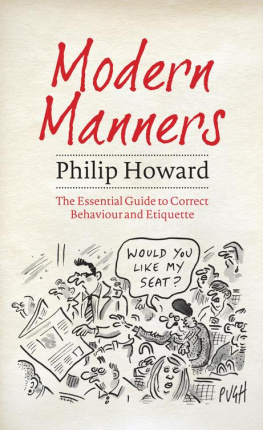Henry Alford - Would It Kill You to Stop Doing That: A Modern Guide to Manners
Here you can read online Henry Alford - Would It Kill You to Stop Doing That: A Modern Guide to Manners full text of the book (entire story) in english for free. Download pdf and epub, get meaning, cover and reviews about this ebook. year: 2012, publisher: Twelve, genre: Detective and thriller. Description of the work, (preface) as well as reviews are available. Best literature library LitArk.com created for fans of good reading and offers a wide selection of genres:
Romance novel
Science fiction
Adventure
Detective
Science
History
Home and family
Prose
Art
Politics
Computer
Non-fiction
Religion
Business
Children
Humor
Choose a favorite category and find really read worthwhile books. Enjoy immersion in the world of imagination, feel the emotions of the characters or learn something new for yourself, make an fascinating discovery.

- Book:Would It Kill You to Stop Doing That: A Modern Guide to Manners
- Author:
- Publisher:Twelve
- Genre:
- Year:2012
- Rating:3 / 5
- Favourites:Add to favourites
- Your mark:
- 60
- 1
- 2
- 3
- 4
- 5
Would It Kill You to Stop Doing That: A Modern Guide to Manners: summary, description and annotation
We offer to read an annotation, description, summary or preface (depends on what the author of the book "Would It Kill You to Stop Doing That: A Modern Guide to Manners" wrote himself). If you haven't found the necessary information about the book — write in the comments, we will try to find it.
Henry Alford: author's other books
Who wrote Would It Kill You to Stop Doing That: A Modern Guide to Manners? Find out the surname, the name of the author of the book and a list of all author's works by series.
Would It Kill You to Stop Doing That: A Modern Guide to Manners — read online for free the complete book (whole text) full work
Below is the text of the book, divided by pages. System saving the place of the last page read, allows you to conveniently read the book "Would It Kill You to Stop Doing That: A Modern Guide to Manners" online for free, without having to search again every time where you left off. Put a bookmark, and you can go to the page where you finished reading at any time.
Font size:
Interval:
Bookmark:

In accordance with the U.S. Copyright Act of 1976, the scanning, uploading, and electronic sharing of any part of this book without the permission of the publisher constitute unlawful piracy and theft of the authors intellectual property. If you would like to use material from the book (other than for review purposes), prior written permission must be obtained by contacting the publisher at permissions@hbgusa.com. Thank you for your support of the authors rights.

In which the author visits the worldwide epicenter of manners, and has a vexing experience with bananas.
Y ou need spend only twenty-four hours in my beloved New York City to unearth the citys essential truth: People really know how to spit here. These aint no dainty, Catherine Deneuvetype loogies were talkin about, yothese are liquid blow darts. This shitll mess you up.
Also: Looking for a fun little fistfight, or to be casually body-checked? Need compelling evidence that rabble does not require more than one rabbler?
We got you covered.
Which is why Id traveled almost seven thousand miles from my home to Japan.
Japan, the Fort Knox of the World Manners Reserve.
The best way to get a really good look at something in your day-to-day life is, of course, to not look at it at all. Leave it behind in a pile on the floor. Go somewhere where things are so different, where every one of your preconceptions and assumptions will be made so glaringly obvious, it will be like looking at pictures of yourself naked: searingly verit.
If the thing you want to look at is manners, and the place you go to is Japan, all the better: here is a place where etiquette has been burnished to a high art. To enter these highly codified realms is to be alternately baffled, delighted, aggrieved, wonderstruck.
I had two teachers during my stay in Tokyo. The first was a Japanese etiquette coach Id hired for a two-hour lesson. A warm, attractive, bespectacled woman in her thirties, Aiko Uda offered cultural immersion classes to individuals and groups in Tokyo; formerly, while living in Canada, she helped hotels and other companies understand the psyches of their Japanese customers.
Aiko had asked me to meet her in a caf near the Shinjuku subway station. Her vibe was equal parts friendly and purposefulfamily pet meets loan officer.
What do you notice when youre riding on the subway? Aiko asked me early on in our session.
No one eats, I suggested.
Right. No eating or drinking. And a lot of text messaging but no phone calls. She added, Theres so much social pressure here. If someone talked on a phone, people would stare, and that would be a big deal. Its a lot more like a collective here.
Trying not to let Aiko see me, I casually brushed a piece of my green tea muffin into a napkin in an effort at crumb management.
Aiko smiled warmly and then proceeded to run the Japanese manners gauntlet for me.
Slippers: Take your shoes off at the entrance to apartments and any building where others are doing so. Wear slippers on the intermediary flooring, and wear only socks on the tatami. Dont wear the bathroom slippers anywhere but the bathroom, even if they are more you than the slippers offered you on arrival.
Pointing: Dont point with your fingers or feet like an orangutan. If you must indicate something, use your palm.
Eye contact: Too much direct eye contact will freak out your interlocutors. Lose the beadiness, my friend.
Doing business in Japan: Be punctual. Wear a dark, conservative suit. Bring a wrapped gift from a department stores food court; spend about ten to twenty thousand yen, and present it with a lot of self-effacing remarks about the gifts modesty. Have a lot of business cards to hand out. Try to hand out and receive the business cards with both of your hands. Put others business cards faceup in front of you on a desk or table so you can refer to them. Take notesits considered respectful and not wonkish.
The loveliest piece of instruction Aiko offered started with her observation, We also have this idea of saving face. From the collective. Not to embarrass someone. So when someone mispronounces a word or is unaccountably ignorant of the correct word or term to be used in a conversation, Japanese people will ofteninstead of outright correcting the persongracefully interject the correct word into their response. If a visitor to Japan marvels at having flown over a very large mountain that bore an exceptional resemblance to a flattened snow cone, his polite Japanese interlocutor knows to seamlessly drop Mount Fuji or Fuji-san into his response. Calamitous embarrassment: neatly dodged.
Aiko wondered if I had any questions.
I read that its considered impolite to sneeze in public, I said.
Sneezing is a dirty thing to do. If you can get out of that situation, you should.
Okay, I said, my mind conjuring the image of a sneeze-threatened salaryman hurriedly getting up from a conference table during a meeting and then plunging out a skyscrapers window.
If you must, you must. Do it into a napkin that is disposable.
Got it.
I also had a noodle question.
Id read in various books that the Japanese audibly slurp their ramen or soba noodles; indeed, two days earlier, my boyfriend, Greg, and I had gone to a mom-and-pop lunch counter to eat terrific bowls of ramen with sliced pork. Unhabituated to slurping as we are, we hadnt made any noise, and Id wondered if the mom and pop had been a little disappointed in us.
I asked Aiko, Is it rude not to slurp noodles?
They would make an exception for you. You are a foreigner and you look like a foreigner.
We were the only Westerners in this noodle bar. The slurping: It was a wall of sound.
Maybe sometimes people would look at youthe same as if Japanese people used a knife and fork to eat french-fried potatoes.
Ive eaten french fries with a knife and fork before: very nice.
My other etiquette coach in Tokyo was self-elected. Greg and I had walked around Tokyos bustling wholesale fish market, Tsukiji, one day, and stopped to have sushi at one of the tiny, ramshackle restaurants located near the fish-selling. Id already learned a lot of restaurant etiquette from books and from Aiko: Dont wipe your face with the hot towel. Use the top ends, not the licked ends, of your chopsticks to take food from a common dish. Hold the rice bowl up close to your mouth, to avoid spilling. Pour sake for others, and let others pour sake for you, but never pour for yourself.
But it was J.J., our waiter at the restaurant at Tsukiji, who gave me the gift of please. About five feet tall and in his forties, J.J. wore a down vest, designer sunglasses that rested over his ski cap, and a tool belt that dripped with key chains on thin straps of leather; the look was very Gay Ski-Lift Operator.
Typically, I like a waiter or waitress who will flirt with me a tiny bit, just so I know Im still in the game, but J.J.s client comportment was less romance than car wash. Emitting a constant stream of excited chattering in his high-pitched nasal voice, he became a blur of suggestions and salutations, an affection dervish.
And then there were the mimeographs that he handed outjumbled, handwritten concatenations of text featuring phrases and dining instructions in English. Prominently featured on them was the phrase onegai shimasu (own-uh-guy shi-MOZ-zoo).
J.J. told me, You can say Sashimi, onegai shimasu. At end of meal, Check. Onegai shimasu.
I nodded and then onegai-shimasu
Next pageFont size:
Interval:
Bookmark:
Similar books «Would It Kill You to Stop Doing That: A Modern Guide to Manners»
Look at similar books to Would It Kill You to Stop Doing That: A Modern Guide to Manners. We have selected literature similar in name and meaning in the hope of providing readers with more options to find new, interesting, not yet read works.
Discussion, reviews of the book Would It Kill You to Stop Doing That: A Modern Guide to Manners and just readers' own opinions. Leave your comments, write what you think about the work, its meaning or the main characters. Specify what exactly you liked and what you didn't like, and why you think so.







